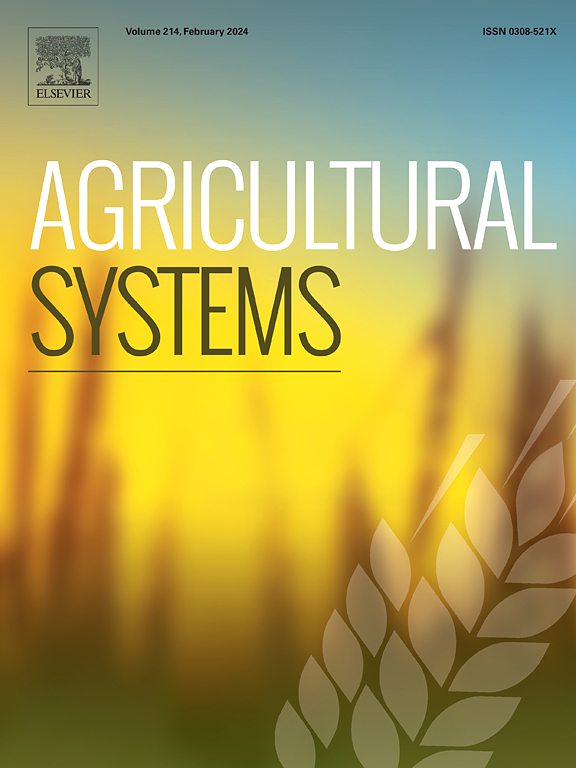印度因棉铃虫和烂铃病造成的棉花产量损失的田间估计
IF 6.1
1区 农林科学
Q1 AGRICULTURE, MULTIDISCIPLINARY
引用次数: 0
摘要
棉铃虫(PBW)对Bt抗性的发展和棉铃腐病(BR)的上升对印度棉花生产构成了重大挑战。PBW和BR都通过破坏种子和皮棉而显著降低棉花产量。PBW引起的损害往往类似于BR感染,导致误诊和不正确的控制措施。由于缺乏量化PBW和BR造成的产量损失的精确方法,导致了本研究的起源。本文章由计算机程序翻译,如有差异,请以英文原文为准。

Field estimates of current and predicted cotton yield loss due to pink bollworm and boll rot in India
Context
The development of pink bollworm (PBW) resistance to Bt cotton and the rise of boll rot (BR) disease pose significant challenges to cotton production in India. Both PBW and BR significantly reduce cotton yields by damaging seeds and lint. Damage caused by PBW often resembles BR infection leading to misdiagnosis and incorrect control measures. The lack of precise methods for quantifying yield losses caused by PBW and BR prompted genesis of this study.
Objective
This study aimed to develop a reliable and robust method for quantifying yield losses caused by PBW and BR, and to predict future yield loss trends for PBW by integrating a phenology model with field data collected from various cotton-growing regions of India.
Methods
Yield loss calculation involved assessing the PBW and BR incidence levels and working proportionate weight loss in randomly sampled loculi from cotton fields. Using a temperature-driven phenology model coupled with a geographic information system, PBW infestation risk was mapped across India's cotton-growing areas and its population growth was simulated under various climate change scenarios predicting temperature rise between 0.5 and 2.5 °C over current temperature. Phenology model driven activity index, expressed as population abundance of PBW was regressed over field damage data from 15 different Indian cotton-growing locations to predict future yield loss trends under climate change scenarios.
Results and conclusions
Without control measures, PBW and BR individually could cause potential yield losses of ∼25 %, equating to an annual loss of 4.27 million tons out of 17.09 million tons of seed cotton produced in India. With control measures, PBW caused an actual yield loss of 3.75 %, equating 0.64 million tons of seed cotton, annually. Currently PBW undergoes over six generations annually in about 60 % of India's cotton-growing areas, increasing to 80 % by 2050 with climate change. Future PBW population abundance is expected to decline due to reduced survival and reproduction at higher temperatures, resulting in a slight decline in future yield loss trends.
Significance
This study provides a robust and reliable tool for quick yield loss assessment during pest or disease outbreaks and also introduces a new dimension of linking PBW phenology model with actual field damage data to improve management strategies for cotton pink bollworm.
求助全文
通过发布文献求助,成功后即可免费获取论文全文。
去求助
来源期刊

Agricultural Systems
农林科学-农业综合
CiteScore
13.30
自引率
7.60%
发文量
174
审稿时长
30 days
期刊介绍:
Agricultural Systems is an international journal that deals with interactions - among the components of agricultural systems, among hierarchical levels of agricultural systems, between agricultural and other land use systems, and between agricultural systems and their natural, social and economic environments.
The scope includes the development and application of systems analysis methodologies in the following areas:
Systems approaches in the sustainable intensification of agriculture; pathways for sustainable intensification; crop-livestock integration; farm-level resource allocation; quantification of benefits and trade-offs at farm to landscape levels; integrative, participatory and dynamic modelling approaches for qualitative and quantitative assessments of agricultural systems and decision making;
The interactions between agricultural and non-agricultural landscapes; the multiple services of agricultural systems; food security and the environment;
Global change and adaptation science; transformational adaptations as driven by changes in climate, policy, values and attitudes influencing the design of farming systems;
Development and application of farming systems design tools and methods for impact, scenario and case study analysis; managing the complexities of dynamic agricultural systems; innovation systems and multi stakeholder arrangements that support or promote change and (or) inform policy decisions.
 求助内容:
求助内容: 应助结果提醒方式:
应助结果提醒方式:


